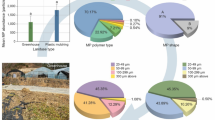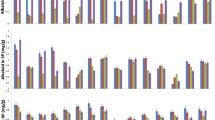Abstract
Polypropylene (PP) has been widely used industrially in several sectors, mainly in the use of packaging of different products. Thus, this has been accumulated in our environment due to the incorrect disposal and its high resistance toward degradation, causing an array of environmental impacts. With this, one alternative that has been explored to minimize the problems intensified by these residues is the use of pro-degrading additives. Therefore, the aim of this work is to evaluate the degradation process of PP blends in soil using enzymatic additive. The soil degradation experiment was done for 6 months; monthly collected samples were checked for alterations on the material properties during that time. The extent of PP degradation with enzymatic additive was compared to an organic additive by techniques of FTIR, TGA, DSC, carbonyl index (CI), and crystallinity. From the obtained results it was observed that the additives influenced the degradation of PP. In addition, the enzymatic additive caused more significant changes in the CI (increase of 3693%), crystallinity (variation of 18.7%), and structural characteristics, indicating a greater influence on the degradation process in relation to the organic additive. In this way, this work has had an important role in the research and development of biodegradable materials with the aim of minimizing the effects induced by plastic waste in the environment.







Similar content being viewed by others
References
Bilal M, Adeel M, Rasheed T, Zhao Y, Iqbal HM (2019) Emerging contaminants of high concern and their enzyme-assisted biodegradation – A review. Environ Int 124:336–353
Jose J, Nag A, Nando GB (2014) Environmental ageing studies of impact modified waste polypropylene. Iran Polym J 23:619–636
ABIPLAST (2018) Perfil 2017 da Indústria brasileira de transformação e reciclagem de material plástico. Indústria Bras Transform e Reciclagem Mater Plástico 1–43
Miyazaki K, Arai T, Shibata K, Terano M, Nakatani H (2012) Study on biodegradation mechanism of novel oxo-biodegradable polypropylenes in an aqueous medium. Polym Degrad Stab 97:2177–2184
Rosevelt C, Los Huertos M, Garza C, Nevins HM (2013) Marine debris in central California: quantifying type and abundance of beach litter in Monterey Bay, CA. Mar Pollut Bull 71:299–306
Achilias DS, Roupakias C, Megalokonomos P, Lappas AA, Antonakou EV (2007) Chemical recycling of plastic wastes made from polyethylene (LDPE and HDPE) and polypropylene (PP). J Hazard Mater 149:536–542
Lazarevic D, Aoustin E, Buclet N, Brandt N (2010) Plastic waste management in the context of a European recycling society: comparing results and uncertainties in a life cycle perspective. Resour Conserv Recycl 55:246–259
Faria AU, Martins-Franchetti SM (2010) Biodegradação de filmes de polipropileno (PP), poli(3-hidroxibutirato) (PHB) e blenda de PP/PHB por microrganismos das águas do Rio Atibaia. Polímeros 20:141–147
Wan L, Zhou S, Zhang Y (2019) Parallel advances in improving mechanical properties and accelerating degradation to polylactic acid. Int J Biol Macromol 125:1093–1102
Ganapathy K, Ramasamy R, Dhinakarasamy I (2018) Polyhydroxybutyrate production from marine source and its application. Int J Biol Macromol 111:102–108
Chen DR, Bei JZ, Wang SG (2000) Polycaprolactone microparticles and their biodegradation. Polym Degrad Stab 67:455–459
Ojeda TFM, Dalmolin E, Forte MMC, Jacques RJ, Bento FM, Camargo FA (2009) Abiotic and biotic degradation of oxo-biodegradable polyethylenes. Polym Degrad Stab 94:965–970
Rosa D, Penteado D, Calil M (2000) Propriedades térmicas e biodegradabilidade de PCL e PHB em um pool de fungos. Polímeros Ciência e Tecnol 15:75–80
Liu X, Gao C, Sangwan P, Yu L, Tong Z (2014) Accelerating the degradation of polyolefins through additives and blending. J Appl Polym Sci 131:9001–9015
Contat-Rodrigo L (2013) Thermal characterization of the oxo-degradation of polypropylene containing a pro-oxidant/pro-degradant additive. Polym Degrad Stab 98:2117–2124
Miyazaki K, Nakatani H (2009) Preparation of degradable polypropylene by an addition of poly(ethylene oxide) microcapsule containing TiO2. Polym Degrad Stab 94:2114–2120
Fontanella S, Bonhomme S, Brusson JM, Pitteri S, Samuel G, Pichon G, Lacoste J, Fromageot D, Lemaire J, Delort AM (2013) Comparison of biodegradability of various polypropylene films containing pro-oxidant additives based on Mn, Mn/Fe or Co. Polym Degrad Stab 98:875–884
Thomas NL, Clarke J, McLauchlin AR, Patrick SG (2012) Oxo-degradable plastics: degradation, environmental impact and recycling. Proc Inst Civ Eng Waste Resour Manag 165:133–140
Mohamad N, Zainol NS, Rahim FF, Maulod HEA, Rahim TA, Shamsuri SR, Azam MA, Yaakub MY, Abdollah MFB, Manaf MEA (2013) Mechanical and morphological properties of polypropylene/epoxidized natural rubber blends at various mixing ratio. Procedia Eng 68:439–445
Barbeş L, Rădulescu C, Stihi C (2014) ATR-FTIR spectrometry characterisation of polymeric materials. Rom Reports Phys 66:765–777
Ma TS, Gutterson M (1972) Organic elemental analysis. Anal Chem 44:445–457
Tavares LB, Rocha RG, Rosa DS (2017) An organic bioactive pro-oxidant behavior in thermal degradation kinetics of polypropylene films. Iran Polym J 26:273–280
Stuart B (2004) Infrared spectroscopy: fundamentals and applications. Wiley, West Sussex
Silverstein RM, Bassler GC (1963) Spectrometric identification of organic compounds. J Med Chem 6:826–827
Montagna LS, Forte MMC, Santana RMC (2013) Induced degradation of polypropylene with an organic pro-degradant additive. J Mater Sci Eng A 3:123–131
Peixoto J, Silva LP, Krüger RH (2017) Brazilian Cerrado soil reveals an untapped microbial potential for unpretreated polyethylene biodegradation. J Hazard Mater 324:634–644
Skariyachan S, Patil AA, Shankar A, Manjunath M, Bachappanavar N, Kiran S (2018) Enhanced polymer degradation of polyethylene and polypropylene by novel thermophilic consortia of Brevibacillus sps. and Aneurinibacillus sp. screened from waste management landfills and sewage treatment plants. Polym Degrad Stab 149:52–68
Auta HS, Emenike CU, Jayanthi B, Fauziah SH (2018) Growth kinetics and biodeterioration of polypropylene microplastics by Bacillus sp. and Rhodococcus sp. isolated from mangrove sediment. Mar Pollut Bull 127:15–21
Gulmine JV, Janissek PR, Heise HM, Akcelrud L (2003) Degradation profile of polyethylene after artificial accelerated weathering. Polym Degrad Stab 79:385–397
Albertsson AC, Andersson SO, Karlsson S (1987) The mechanism of biodegradation of polyethylene. Polym Degrad Stab 18:73–87
Das MP, Kumar S (2015) An approach to low-density polyethylene biodegradation by Bacillus amyloliquefaciens. 3 Biotech 5:81–86
Fletcher M (1996) Bacterial adhesion: molecular and ecological diversity. Willey, New York
Neu TR (1996) Significance of bacterial surface-active compounds in interaction of bacteria with interfaces. Am Soc Microbiol 60:151–166
Gu JD (2003) Microbiological deterioration and degradation of synthetic polymeric materials: recent research advances. Int Biodeterior Biodegrad 52:69–91
Matsunaga M, Whitney PJ (2000) Surface changes brought about by corona discharge treatment of polyethylene film and the effect on subsequent microbial colonisation. Polym Degrad Stab 70:325–332
Husarova L, Machovsky M, Gerych P, Houser J, Koutny M (2010) Aerobic biodegradation of calcium carbonate filled polyethylene film containing pro-oxidant additives. Polym Degrad Stab 95:1794–1799
Sivan A (2011) New perspectives in plastic biodegradation. Curr Opin Biotechnol 22:422–426
Arkatkar A, Arutchelvi J, Sudhakar M, Bhaduri S, Uppara PV, Doble M (2009) Approaches to enhance the biodegradation of polyolefins. Open Environ Eng J 2:68–80
Chawla S, Ghosh AK, Ahmad S, Avasthi DK (2006) Swift heavy ion induced structural and chemical changes in BOPP film. Nucl Instruments Methods Phys Res Sect B Beam Interact Mater Atoms 244:248–251
Cadenato A, Ramis X, Salla JM, Morancho JM, Contat-Rodrigo L, Vallés-Lluch A, Ribes-Greus A (2006) Calorimetric studies of PP/Mater-Bi blends aged in soil. J Appl Polym Sci 100:3446–3453
Sheik S, Chandrashekar KR, Swaroop K, Somashekarappa HM (2015) Biodegradation of gamma irradiated low density polyethylene and polypropylene by endophytic fungi. Int Biodeterior Biodegrad 105:21–29
Longo C, Savaris M, Zeni M, Brandalise RN, Grisa AMC (2011) Degradation study of polypropylene (PP) and bioriented polypropylene (BOPP) in the environment. Mater Res 14:442–448
Rivaton A, Gardette JL, Mailhot B, Morlat-Therlas S (2005) Basic aspects of polymer pegradation. Macromol Symp 225:129–146
Ramos M, Jiménez A, Peltzer M, Garrigós MC (2012) Characterization and antimicrobial activity studies of polypropylene films with carvacrol and thymol for active packaging. J Food Eng 109:513–519
Persico P, Ambrogi V, Carfagna C, Cerruti P, Ferrocino I, Mauriello G (2009) Nanocomposite polymer films containing carvacrol for antimicrobial active packaging. Polym Eng Sci 49:1447–1455
Valle MLM, Guimarães MJOC (2004) Degradação de poliolefinas utilizando catalisadores zeolíticos. Polímeros Ciência e Tecnol 14:17–21
Acknowledgements
The present work was performed with the support of Coordination of Improvement of Higher Level Personnel—Brazil (CAPES)—Finance Code 001, and Brasilata Company.
Author information
Authors and Affiliations
Corresponding author
Rights and permissions
About this article
Cite this article
Pires, J.P., Miranda, G.M., de Souza, G.L. et al. Investigation of degradation of polypropylene in soil using an enzymatic additive. Iran Polym J 28, 1045–1055 (2019). https://doi.org/10.1007/s13726-019-00766-8
Received:
Accepted:
Published:
Issue Date:
DOI: https://doi.org/10.1007/s13726-019-00766-8




